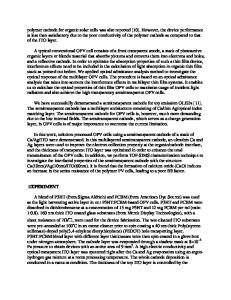CuO photocathode-embedded semitransparent photoelectrochemical cell
- PDF / 612,201 Bytes
- 9 Pages / 584.957 x 782.986 pts Page_size
- 45 Downloads / 319 Views
A semitransparent CuO film was applied for photoelectrochemical (PEC) cell to produce the record-high photocurrent (6.4 mA/cm2) for nanocrystalline monoclinic CuO photocathode. Large-scale affordable reactive-sputtering method was effectively formed Cu oxide films and sequential thermal processes efficiently controlled the Cu oxide phases with enhanced optical-transparency of Cu oxide films. Structural, physical, optical, and electrical properties of various Cu oxide films (CuO, Cu4O3, and Cu2O) were systematically investigated according to the sputtering condition and thermal processes. It was found that the energy band gap of CuO can be tuned from 1.7 to 1.9 eV by modulating the oxygen flow for reactive sputtering. Mott–Schottky analyses revealed the flat band potential close to the 0.96 V versus reversible hydrogen electrode and energy band edges of Cu oxide films. This state-of-the-art CuO photocathode would provide a strong potential for wide applications of the transparent PEC system of on-site energy generation. I. INTRODUCTION
Hydrogen has been considered as a future energy carrier. 1–3 Hydrogen production using solar-driven water splitting has a high potential to envision the approach of clean and sustainable energy supply system. This concept is satisfactory for on-site energy generation, storage, and utilization. An effective way of hydrogen production can be realized by photoelectrochemical (PEC) cell. The universal sunlight would benefit to generate electricity on-site of energy demand using semiconductor/ electrolyte interfaced PEC cell. Therefore, high interests have been emerged to find an appropriate semiconductor material, which can effectively absorb the sunlight for long-term stability.4–6 If the transparent PEC system is performed, more possibility of on-site energy utilization can be realized. The most conventional approach for solar fuel (H2) production using PEC water splitting applies a single semiconductor photoelectrode (photocathode) with a Pt counter electrode. The overall event of PEC is two hydrogen molecules production by the water reduction reaction upon the absorbed four photons; meanwhile, the water oxidation reaction induces one molecular O2 after taking four holes. Researchers have tried to alternate Pt metal electrode by the photoanode materials (e.g., n-Si, BiVO4, Fe2O3, MoS2, and SnS), which have a smaller
Contributing Editor: Xiaobo Chen a) Address all correspondence to this author. e-mail: [email protected] DOI: 10.1557/jmr.2016.364
band gap than that of the photocathode. In the aspect of photon utilization, transparent photocathode would allow to pass the photons reaching to photoanode. This transparent photocathode scheme would be considered for one promising approach to realize the theoretical solar to hydrogen efficiency limits of .25%.4,6–13 Among metal oxides, Cu oxides such as CuO, Cu2O, and Cu4O3 are attractive because of their abundance, nontoxic and low cost features, affordable fabrication.14–23 Various Cu oxides have been reported by using TiO2 protected Cu2O film24
Data Loading...











